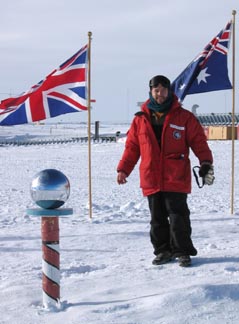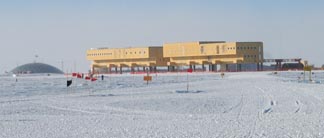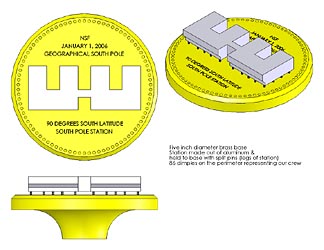 Thomas Nikola |
| Cornell engineer Stephen Parshley stands before the Ceremonial South Pole. His winning design will mark the Geographic South Pole, currently about 50 feet away, which, unlike the Ceremonial Pole, is measured each year to compensate for shifting ice. Copyright © Cornell University |
ITHACA, N.Y. -- Stephen Parshley, a research support engineer in Cornell University's astronomy department, has plans to leave his mark on the world. Literally. The plans are Parshley's winning design for the 2006 South Pole marker.
The marker will be fabricated and placed at the exact geographic location of the Earth's South Pole on New Year's Day 2006 and will remain as the pole's official landmark for one year.
For the past three years, Parshley, 30, had been throwing on a jacket, grabbing an umbrella and driving his pickup truck from his apartment to work in a climate-controlled laboratory on Cornell's campus. This year, however, he puts on insulated undergarments, a fur-lined parka, ski goggles and lip balm and walks in the pitch black through knee-high snowdrifts and wind chills as low as 140 degrees below zero Fahrenheit to get from his sleeping quarters at the U.S. Amundsen-Scott South Pole Station to a telescope facility 1 kilometer away, where he is a co-operator.
The facility, the Antarctic Submillimeter Telescope and Remote Observatory, houses the South Pole Imaging Fabry-Perot Interferometer (SPIFI), a Cornell-owned instrument for observing star-forming regions of nearby galaxies. Parshley helped build the instrument when he was at Cornell.
Now he is a member of the South Pole "winter-over" crew -- an elite group of 86 hardy souls representing a wide range of specific trades who occupy the station during the eight-month-long Antarctic winter, from mid-February through late October, when extreme weather prohibits any flights into or out of the area. Surrounded by nothing but a flat, moonlike desert of ice and snow for hundreds of miles in all directions, the crew lives in true isolation. Parshley volunteered (yes, volunteered) for the stint after taking a liking to the natural beauty, rugged lifestyle and the station's sense of community and purpose when he spent several weeks installing SPIFI there two Antarctic summers ago.
To keep from going crazy, winter-overs engage in a number of recreational activities, including an annual South Pole marker design contest. The competition's only rules are that the marker must be able to be constructed from the somewhat limited materials and tools available at the station and that it must carry a few specific lines of official text. Any winter-over may enter a design, and the entire crew votes to decide the winner.
On June 13, news of Parshley's winning design came by e-mail, since satellite Internet is the only contact the winter-overs currently have with the outside world, other than Iridium phones. The design, which took Parshley about 15 hours, is both simple in structure and deep in symbolism. Its defining feature is a miniature aluminum model of the station's new elevated building. The model stands at the center of a 5-inch-diameter brass disk and is encircled by 86 dimples, representing the members of the winter-over crew.
 Thomas Nikola |
| Parshley's design incorporates a model of the new elevated building at the U.S. Amundsen-Scott South Pole Station. |
Astronomy professor Gordon Stacey, who is Parshley's boss, called the win "a great honor."
"Since all the past pole markers have been basically flat with relief-style engraving, I'd been playing around for some time with the idea of pushing the marker into the third dimension," recalled Parshley. "I also wanted to represent our winter-over crew … and keep the machining simple. Then it just hit me: the elevated station surrounded by 86 dimples. Straightforward, yet meaningful."
Parshley's mini station is approximately one-thousandth the size of the station's massive, ultramodern, elevated building, which has become the icon of the South Pole. Scheduled for completion in 2007, the structure eventually will house 152 berths, a dining hall, bar, basketball court, library, greenhouse, medical clinic and scientific labs. It is "elevated" by 36 tubular steel stilts, a design that was supposed to eliminate snowdrifts by allowing wind to blow underneath. Nevertheless, a 12-foot wall of snow had to be bulldozed away last summer.
"I wonder if my mini station will accumulate its own mini snowdrift," Parshley joked by e-mail. It probably will. Tiny aluminum standoffs will replicate the stilts, and the model will sit just 50 feet upwind from the real thing.
When asked if his engineering background gave him an unfair advantage, Parshley admitted that he did check to see if the rates of thermal contraction of brass and aluminum were well matched (they are). He also used professional drafting software to draw the marker. However, "I could have just as easily designed something that people didn't like," he pointed out.
 |
| Parshley's winning design for the 2006 South Pole marker. Click on the image for a high-resolution version (792 x 612 pixels, 192K) |
Among the five entries in this year's competition were a design with a snowflake on top of an intricate map of Antarctica sandblasted into a round medallion and a "retro" design whereby text would be hammered into a piece of copper in homage to markers of the earliest days of the station.
Representatives of the National Science Foundation (NSF) in Washington, D.C., who must approve the winning design before fabrication can begin, said that one of the selling points of Parshley's marker was its simpler design, since "things have gotten very complex in recent years."
The marker will be fabricated at the South Pole over the next few months by Parshley and Allan Day, the station's machinist, who estimates that it will take 60 to 70 hours in total.
Once the marker is completed, each member of the 2005 winter-over crew will engrave his or her name onto the underside of the brass disk during a traditional signing ceremony. Parshley will not actually be present when the marker is installed on New Year's Day, since his winter-over tenure ends in October. However, because he subsequently plans to do some recreational traveling around the tropical islands of Asia and the South Pacific, he is not too upset.
Parshley, who earned his B.S. degree in mechanical engineering at Cornell in 1998, will resume his job on campus in January 2006. He has not commented on whether he will return to the South Pole in the future.
Thomas Oberst is a writer intern at the Cornell News Service.
